Bio of Vertebrates - Exam 2
1/109
Earn XP
Description and Tags
Chapter 3: Jawless vs. Jaws 4: Living Chap, 6: Chondritchyes.
Name | Mastery | Learn | Test | Matching | Spaced |
|---|
No study sessions yet.
110 Terms
Agnathas
-Paraphyletic Group. Earliest vertebrates.
-Lack jaws, paired appendages (most) and other derived gnathostome features.
-Only Hagfishes (Myxiniformes) and Lampreys (Petromyzoniformes) are extant, but more primitive (less derived) than “Ostracoderms”.
Condonts (Conodonta)
-Small tooth-like structures in pharynx.
-Numerous small (<1 mm), tooth-like structures in marine fossil deposits.
-Made of a hard, mineralized tissue of calcium phosphate (apatite), similar in structure to vertebrate hard tissues.
-Mineralized tissues containing crystals of hydroxyapatite, including bone, dentine, enamel, are derived features of vertebrates.
-Structures are complex apparatus in the pharynx of small early vertebrates, bearing their name.
-Small fossil impressions of soft tissues indicate other primitive vertebrate features: including notochord, cranium, myomeres, and large eyes.
Ostracoderms
External covering of dermal bone, as a shell, plates, or scales.
Myxiniformes (Hagfishes)
-Marine, most in deep, cold waters"
-Scavengers; “sucker” onto large carcasses and use a knot in their body to push away, tearing off a piece of flesh.
-Slime defense: large mucus glands secrete copious quantities of mucus and proteinaceous fibers which hold “slime” around body.
-Horny (not mineralized) plates in mouth and “teeth” on tongue.
-Eyes degenerate, covered by skin.
-Apparently have no larval stage, but few fertile eggs have ever been found.
-Source of almost all “eel skin” leather
-Over-fishing has depleted many populations.
-Soft-bodied, no mineralized hard tissues.
-No trace of vertebrate, not even vertebral cartilages on sheath of notochord.
-No paired appendages.
-Single nasal opening, only one semi-circular canal in the inner ear (on each side)
Petromyzoniformes (The Lampreys)
-Anadromous (adults live in oceans or large lakes and migrate up streams to breed)
-Parasites; “sucker” onto large fishes or whales and scrape away the integument.
-Horny (not mineralized) “teeth” on mouth and tongue.
-Food is almost exclusively body fluids of fishes.
-Straight, simple digestive tract.
-Oral gland secretes an anticoagulant.
-Larvae (ammocoetes) very distinct from adults- filter-feeding- long thought to be different species.
-Well developed eyes.
-Soft-bodied- no mineralized hard tissues.
-Vertebral cartilages (arculia) on sheath of notochord, form partial neural arches.
-No paired appendages.
-Single nasal opening.
-Two semicircular canals in inner ear.
Jawless Osteognathostomes
Have dermal bone but no jaws
Ostracoderms (the armored jawless fishes)
-Extinct, but very diverse during Silurian- Devonian
-Paraphyletic, systematics still debated.
-Marine and freshwater.
-Predators= suction of water into mouth drew in small, soft-bodied prey.
-Bony armor present as a carapace (shell), large plates, or smaller scales.
-Mineralized tissues (bone, dentine, and enamel) present in dermal armor, but essentially no bone in internal skeleton.
-Notochord is primary axial support.
-No paired appendages in most- one pair (pectoral) in one clade.
-Immovable projections of carapace functional as “fins” in others.
-Single nasal opening.
-Two semicircular canals in inner ear.
-More derived than extant agnathans
-More closely related to gnathostomes than lampreys or hagfishes are.
Origin of Jaws
-Jaws (upper and lower) developed from the first pharyngeal arch (the Mandibular Arch)
-Second pharyngeal arch- Hyoid Arch- assists in jaw support (connecting jaws to skill).
-First gill slit reduced to a spiracle.
-Original modification of arches was likely to allow more forceful buccopharyngeal pumping of water to ventilate the gills and for suction feeding.
-Acquisition of jaws made a wide variety of foods and feeding methods available for vertebrates; firmly grasp food items or prey, cut or tear off pieces small enough to swallow, crush hard food items.
-Dermal bone forms most of the functional jaws in osteichthyes and tetrapods.
Derived Gnathostome Features
-Jaws
-Two nasal openings
-Spiracle
-Three semicircular canals in inner ear
-Horizontal (transverse) septum divides trunk musculature into epaxial and hypaxial muscles.
-Vertebrae with neural and hemal arches, centra (surroudning or replacing the notochord), and ribs- only arches in earliest taxa.
Placoderms
-Armored Jawed Fishes
-Not monophyletic
-Extinct
-Marine and freshwater
-Predators
-Jointed shield of thick, bony armor on head and anterior body.
-Ossified neural and hemal arches attached to prominent notochord; no centra or ribs.
-Jaws
-Jagged edges of dermal armor along jaws functioned as teeth.
-True teeth (convergent with other gnathostomes) in later forms.
-Paired pectoral and pelvic appendages.
Acanthodians
-Named for stout spines on fins
-Marine and freshwater
-Body covered with small scales
-Ossified neural and hemal arches attached to prominent notochord, no centra or ribs.
-Jaws and true teeth
-Teeth anchored in integument, not jaws, shark-like
-Multiple paired fins in addition to pectoral and pelvic.
The fins to stabilize a fish in three dimensions
-Roll (side to side)
-Yaw (turn)
-Pitch (up-down)
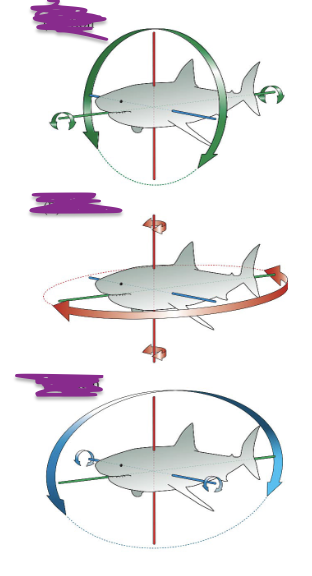
Similarity between air and water
Fluid medium
Air versus Water
-Density
-Viscosity
-Oxygen Content
-Heat Capacity and Conductivity
-Electrical Conductivity
Density
-Water is denser than air
-Water supports an animal’s body; for air you need a weight-bearing skeleton
-Aquatic vertebrates can grow larger than terrestrial forms.
Viscosity
-Water is more viscous than air
-More resistance to movement
-Fishes must be streamlined to minimize drag
-High → also affects ventilation of gills (one-way versus tidal flow)
Oxygen Content
-Air has more O2 than water
-Diffuses much more slowly through water than air.
Heat Capacity and Conductivity
-Specific heat of water is more than air… takes more energy to change the temperature of water than air.
-Water temps more stable than air
-Heat conductivity of water is more than air
-Terrestrial vertebrates have a wider variety of microhabitat temperatures to choose from- if too hot, fish must move to deeper water to cool off
Electrical Conductivity
-Water is much better electrical conductor than air
-Aquatic vertebrates can use electroreception/electrolocation whereas terrestrial can’t.
Gills
-Gas exchange in water (respiration)
-Enclosed in pharyngeal pockets (between pharyngeal arches)
Flow of water is _
Unidirectional
Flow of air to lungs is
tidal-bidirectional
Buccal pumping
Water enters mouth, is pumped over gills by pharyngeal contraction, and exits via opercular openings or gill slits.
Ram ventilation
Used by active swimming fish, swim with mouth open to push water through gills
When oxygen levels of water are too low, what do osteichthyes do?
Use lungs (and other body structure) to breathe air
Facultative air breathers
Switch between gills and lungs as needed
Obligatory air breathers
Will drown if not able to breathe air
Fishes evolved what millions of years before the origin of tetrapods?
Lungs
How are gills of fishes efficient at exchanging gases between water and blood?
-High surface area with many filaments, each with many parallel secondary lamellae
-Blood and water separated by only a thin layer of epithelium
-Parallel arrangement of lamellae direct the flow of water to prolong the contact between water and blood
-Counter-current flow through gill lamellae which maintains a diffusion gradient throughout contact, maximizing gas exchange.
Gill structure
-Arches = structure
-Filaments attached to arches, covered with small blood vessels (capillaries)
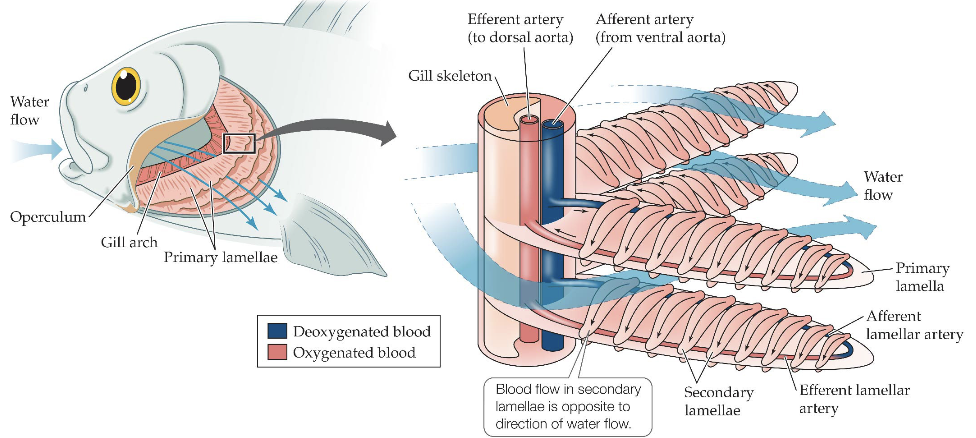
Counter-current exchange
Flow of water over gills and blood through gill lamellae; maintains a diffusion gradient throughout contact.
Only works with unidirectional, not tidal, ventilation.
Gas bladder (Swim bladder)
To maintain neutral buoyancy. In order to change buoyancy, add or remove gas to go up or down in response to depth/pressure.
Gas bladder develops…
as an offshoot of the gut, connected to the esophagus via pneumatic duct.
pneumatic duct
a tube connecting the swim bladder to the esophagus, allowing to control buoyancy by swallowing air to inflate the bladder or ‘burping’ to release it.
Physostomous
Retains pneumatic duct as adult.
Adds high vascularity for gas exchange (A simple lung)
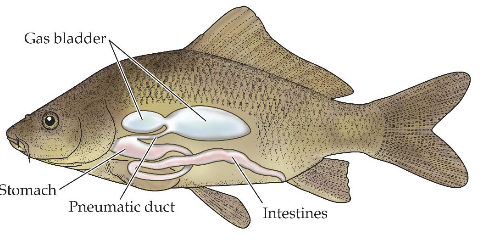
Physoclistous
Lacks pneumatic duct as adult. CANNOT gulp air into bladder and burp out excess air.
-Adds gas to bladder via gas gland with a retemirabile (network of capillaries with countercurrent flow) that secretes oxygen into bladder.
-Excess gas is absorbed into blood by opening the ovale, exposing another capillary bed
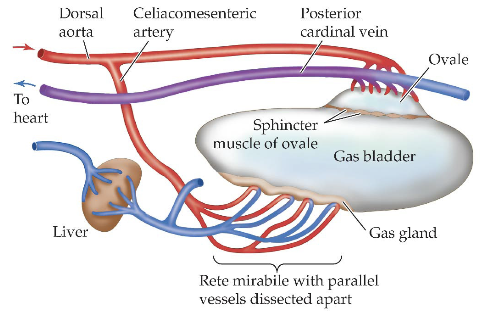
Some Chondricthyes & pelagic Osteichthyes lack buoyancy regulation, so they must what?
Swim constantly… wing like pectoral fins help generate their lift.
Other Chondrichthyes do what to regulate buoyancy?
Use their large livers. Their high liver oil content makes it less dense than water.
Vision
-Light is bent upon entering the eye to focus an image on the retina.
-Water and air have different refractive indices, so how this is done differs between fish and tetrapods.
-Fishes have a spherical lens with high refractive index to focus light on retina- aquatic mammals have separately evolved a similar spherical lens.
Chemosensory
-Fishes have taste buds in mouth, head, and on anterior fins that detect insoluble molecules.
-Olfactory organs on snout detect soluble substances.
Inner Ear - Vestibular Apparatus
-Semi-circular canals detect orientation and movement
-Hair cells detect movement/location of fluid or crystals of calcium carbonate to determine orientation and acceleration.
-Also used to detect sound-pressure waves (hearing) in tetrapods, but not most fishes.
Lateral Line System
-Detects water displacement.
-Hair cells are clustered in neuromast organs, that are dispersed over surface of head and body.
-Many arranged in a canal or lateral line, along the transverse septum (division between dorsal and ventral axial muscles)
-Hair cells of neuromasts detect water movement when current bends/deflects hairs.
-Location and orientation of neuromast organs, and their perceptual fields, allow triangulation to localize source of water movement.
-Present in fishes and aquatic amphibians.
Electroreception in Elasmobranchs
-Can detect electric fields
-Ampullae of Lorenzini which detect differences in electrical potential between surrounding tissue and the external environment (water at skin surface). Electrical fields generated by something other than the fish itself.
-Use this sense to detect the electric fields generated by motor nerve and muscular activity of prey. Therefore, they can find living prey in complete absence of other sensory stimuli (ex: olfactory, visual)
-Can be used to navigate as well (Earth’s magnetic field)
Electric Defense
-Some fish use their own electric discharge for defense or stun prey
-Modified muscle cells (electrocytes) produce high-voltage discharge.
Electrocytes
modified muscle cells that produce high-voltage discharge
Electrolocation
Navigation using electric fields via emitting pulses of electric discharge and sense the resulting field with their electroreceptors. Allows for navigation in total darkness. There are some disruptions in the field such as rocks which alter the distribution of the field over the fish’s body surface.
Can be used for social communication.
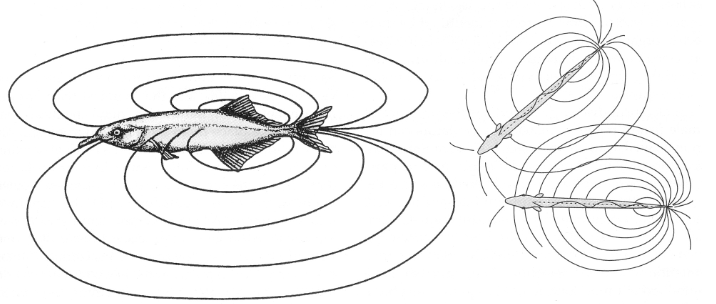
Osmoregulation in Aquatic Vertebrates
To regulate the amounts of water and ions in their body fluids. Kidneys and skin involved.
Kidney role in osmoregulation
removes excess water, salts, metabolic wastes, and foreign substances from the blood, which are excreted as urine.
Skin of fish with osmoregulation
Limited permeability, gills are permeable to water, so are the site of much osmosis and diffusion.
Stenohaline
Fish that only tolerate small changes in salinity. The magnitude and direction of the osmotic gradient they face is stable.
Euryhaline
The few fish that tolerate large changes in salinity. Osmotic gradient they face changes in magnitude and/or direction.
Freshwater Bony Fishes with Osmoregulation
-Are hyperosmotic to the water around them.
-Tend to gain water and lose ions.
-Don’t drink, gain some water with food
-Kidneys produce large quantity of dilute urine and kidney tubules actively reabsorb salts, but lose some in urine.
-Gills actively transport salt ions from water to bloodstream.
-Metabolic waste excreted primarily as ammonia, diffuses from gills.
Freshwater Amphibians and Osmoregulation
-Gain much water via skin
-Skin actively uptakes ions from water.
-Metabolic waste excreted primarily as urea- in urine.
Marine Bony Fishes (Except Coelacanths) with Osmoregulation
-Body fluid is hypoosmotic to seawater.
-Tend to lose water and gain ions.
-Drink much seawater; gain needed water, but also excess salts.
-Kidneys produce small quantity of more concentrated urine.
-Gills actively pump salt ions out into water.
-Metabolic waste excreted primarily as urea.
-Gills actively transport urea out to water.
Marine Cartilaginous Fishes AND Coelacanths with Osmoregulation
-Maintain osmolality of body fluids close to that of seawater.
-Retains urea to make fluids slightly hyperosmotic to seawater.
-Tend to gain water and some ions across gills.
-Do not need to drink much seawater.
-Kidneys produce moderate quantity of urine containing excess salts and urea.
-Kidney tubules actively reabsorb urea (to maintain high osmolatity)
-Gills are largely (but not entirely) impermeable to urea, so doesn’t lose much to diffusion.
-Rectal gland of chondrichthyans secretes excess salt.
Vertebrates excrete nitrogenous waste as…
Ammonia, urea, or uric acid. Proportions vary among groups.
Ammonia
-Very soluble in water and diffuses readily.
-Toxic at low concentrations (must be excreted immediately)
-Requires water for excretion via diffusion from gills into water, or in urine containing much water.
Urea
-Less toxic than ammonia, but more energetically expensive to produce.
-Can be concentrated to conserve water.
-Stored by some marine vertebrates to increase body osmolality.
-Allows waste to be stored until water is available to excrete it.
Uric Acid
-Insoluble and non-toxic.
-Passed as a semi-solid with very little water.
Body Temperature Impact on Vertebrate’s biology
-Influences rate of chemical reactions
-Underlie all activities, including physiological and physical performance.
-Most reactions double to triple their rates over a 10 C rise in temperature.
Poikilotherm
Body temperature varies with changes in environmental temperature
Homeotherm
Body temperature does not vary, even with changes in environmental temperature
Ectotherm
Gains heat primarily from external sources.
Endotherm
Gains heat primarily from its own metabolism.
Fishes and aquatic amphibians body temperature…
Generally ecothermic, but their environment may not change much (~homeothermy)
Reptiles and terrestrial amphibians’s body temperature regulation
Ectothermic, generally poikilothermic.
Birds and mammals body temperature regulation
Endothermic and usually homeothermic, but some are poikilothermic, allowing their body to drop over night/winter (torpor and hibernation)
Fish in cold water
-Muscle activity generates heat, and lose much heat through diffusion to water (thanks to skin and gills). Good for respiration, bad for heat retention.
-Some fish maintain parts of their bodies up to 15 C warmer than surrounding water.
-Counter-current blood flow through capillary beds (retia mirabilia) keep heat generated by muscle activity in important, core organs/tissues.
-Brain, eyes, and/or primary swimming muslces (axial) are kept warmer than other tissues.
-Occurs in many fast-swimming, pelagic fishes; some sharks, tuna, etc.
-Billfishes have modified muscles that no longer contract, but just produce heat.
Marine Mammals in Cold Water
-Maintain high, stable temperatures throughout their body core.
-Lack gills, but still lose heat from their entire body surface.
-Blubber as thermal insulation
-Fur traps in insulating layer of air
-Counter-current heat exchanges in flippers keep heat in body core, allowing flippers to be colder than trunk of body.
-Hot blood sent to flippers when needbe.
Body Size Impact
Greatly on the exchange of heat between an organism and its environment.
Surface area does not _ linearly with body volume
increase; at larger sizes, surface area is smaller relative to volume.
_ increases as the cube of linear dimensions.
Volume
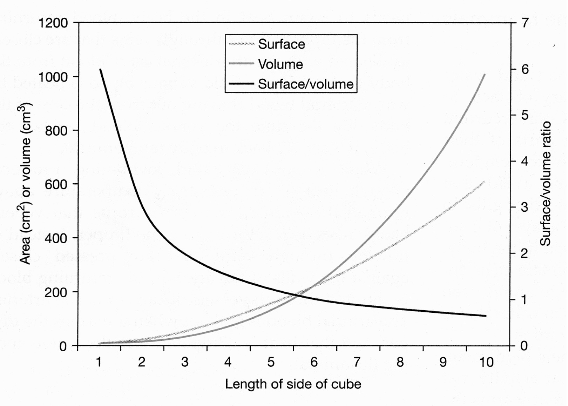
_ increases ONLY as the square of linear dimensions
surface area
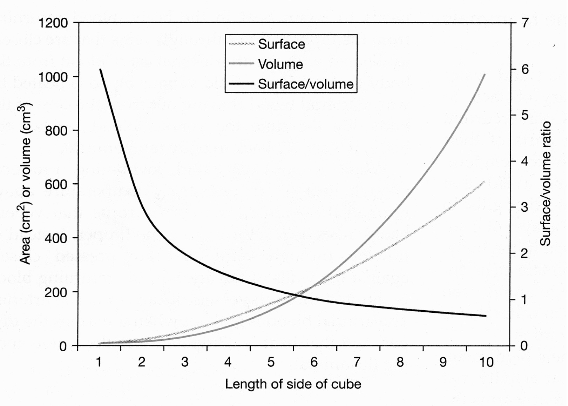
Which exchanges heat (or materials) with their environment less rapidly? Bigger species or smaller species?
Bigger species, because they gain/lose heat more slowly (because of their surface area)
Surface area vs body volume determinations
-Surface area: determines the area for exchange.
-Body volume: determines the amount of material or energy available to (or that needs to) be exchanged.
Chondrichthyes
-Cartilaginous fishes
-Skeleton entirely cartilaginous (bone totally lost)
-Endoskeleton is calcified cartilage
-Posses jaws and internally supported paired appendages
-Combination of jaws and teeth plus precise steering
-Predators (Mostly)
-Lack gas bladder (will sink w/o swimming)
Elasmobranchii (Neoselachii)
-Sharks, skates, and rays
-Plate + gills
-Series of parallel gill slits on either side
-Predators
-Mostly marine
-Dermal denticles (aka placoid scales) on skin
Dermal Denticles
Placoid scales; tiny, tooth-like structures that cover the skin of Elasmobranchii
Holocephali
-Chimeras, ratfishes
-Single gill opening on either side
-Predators
-Marine, usually deep water.
Acanthodians
-Extinct
-Named for stout spines on fins
-Marine and freshwater
-Body covered with small scales
-Ossified neural and hemal arches attached to prominent notchord, no centra or ribs
-Jaws, and true teeth.
-Teeth anchored in integument, now jaws, shark-like
-Multiple paired fins in addition to pectoral and pelvic.
Phylogeny of Chondrichthyes
Chondrichthyes → Holocephali (Chimaeriformes) and Elasmobranchii (Neoselachii (all extant elasmobranchs))
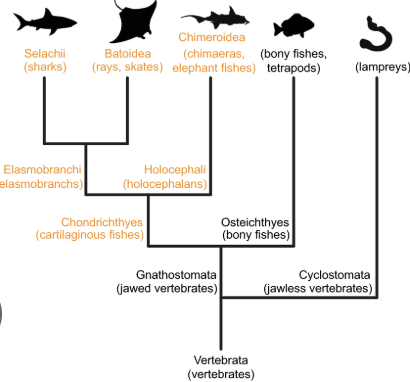
What’s under Neoselachiii phylogeny-wise?
-Galeomorphi (anal fin)
-Squalomorphi (no anal fin)
-Batomorphi (skates and rays)
What’s under Holocephali phylogeny-wise?
Chimaeriformes (ratfishes, chimeras)
Holocephali
-Chimaeriformes (ratfishes and chimaeras)
-Single gill opening on either side
-Marine and benthic (deep water)
-Predators
-Oviparous with proteinaceous egg case
-Male has clasper to grip female during mating
Neoselachii
-All extant elasmobranchs
-Selachii (“sharks”) → Galeomorphi, squalomorphi
-Batomorphi (skates and rays)
Selachii - “sharks”
Galeomorphi and Squalomorphi
Galeomorphi and Squalomorphi
-Usually cylindrical body form
-5-7 gill slits on each side of head
-Many fast-swimming predators
-Dermal denticles reduces turbulence of water flow next to skin
-Heterocercal tail
-Mobile, flexible pectoral fins used to generate lift anteriorly, turn, and stabilize forward movement
-Sensory systems (olfactory, mechanoreceptors, vision, and electroreception) well-adapted for prey detection, pursuit, and attack.
-Cranial Kinesis for prey
-Regional endothermy
Heterocercal tail
-Found in Galeomorphi and Squalomorphi (“sharks”)
-Asymmetrical, larger dorsal lobe
-Generates forward thrust and lift
Cranial Kinesis
Allows consumption of wide range of prey sizes. Mobility within the head skeleton.
Regional Endothermy
In some larger, fast-swimming species… maintaining certain body parts at a higher temperature than the surrounding water. Found in sharks.
Jaw suspension in Elasmobranchs
Hyostylic. Primary support of jaws. The jaw is connected to the skull indirectly via the hyomandibula bone.

Hyoid Arch
The second pharyngeal arch supports the jaw and is critical for feeding and respiration. Hyomandibula is contacted to this.

Hyomandibula
Rear (hinge) of jaws is attached to this, which has a moveable attachment to the chondrocanium (from the hyoid arch).
Oviparity
Egg laying
-Female lays eggs, containing undeveloped embryos
-Eggs enclosed in a shell or case
-Embryos complete development outside of the maternal reproductive tract then hatch from egg.
Ovoviviparity
Eggs develop internally
-Female produces eggs, but these remain within her oviducts throughout development.
-Young hatch before or immediately upon leaving mother’s reproductive tract.
Viviparity
Live bearing
-Female gives birth to fully developed young
Ovoviviparity v. viviparity
-Distinction is dependent on the source of embryonic nutrition
-Not always clear
-Dropped the term “ovoviviparity”.
Lecithotrophy
Embryo gets nutrition from yolk in egg
-All nutrients for development of young are contianed within the egg
Matrotrophy
Embryo gets nutrition from the mother in addition to/instead of from yolk.
-Developing young ingest secretions of the oviduct
-Developing young feed on other ova/embryos
-Developing young get nutrition via placental transfer (placentotrophy) from maternal blood
Reproduction of Elasmobranchs
-All have internal fertilization
-Claspers on pelvic fins of males are inserted into female’s cloaca to transfer sperm
-Oviparous or Viviparous (NO ovoviviparous)
-Lecithotrophic or Matrotrophic
-No parental care after oviposition/birth
-No larval stage; young are usually miniature versions of adults at hatching/birth.